NCERT Solutions Class 9 Maths
Chapter – 9 (Areas of Parallelograms and Triangles)
The NCERT Solutions in English Language for Class 9 Mathematics Chapter – 9 Areas of Parallelograms and Triangles Exercise 9.2 has been provided here to help the students in solving the questions from this exercise.
Chapter 9: Areas of Parallelograms and Triangles
- NCERT Solution Class 9 Maths Ex – 9.1
- NCERT Solution Class 9 Maths Ex – 9.3
- NCERT Solution Class 9 Maths Ex – 9.4
Exercise – 9.2
1. In Fig. 9.15, ABCD is a parallelogram, AE ⊥ DC and CF ⊥ AD. If AB = 16 cm, AE = 8 cm and CF = 10 cm, find AD.
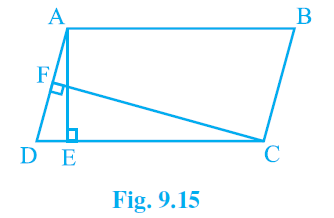
Answer – Given: AB = 16 cm, AE = 8 cm, CF = 10 cm
In parallelogram ABCD, CD = AB = 16 cm [Opposite sides of a parallelogram are equal]
We know that area of a parallelogram = Base × Corresponding altitude
Therefore, Area of a parallelogram ABCD = CD × AE = AD × CF
Here CD and AD act as the base and AE ⊥ CD, CF ⊥ AD are the corresponding altitudes.
∴ AD = (CD × AE) / CF
Substituting the values for CD, AE, and CF, we get AD = (16 × 8) /10 cm = 12.8 cm
Thus, the length of AD is 12.8 cm.
2. If E, F, G and H are respectively the mid-points of the sides of a parallelogram ABCD, show that ar (EFGH) = ar(ABCD).
Answer – If a triangle and parallelogram are on the same base and between the same parallel lines, then the area of the triangle will be half of the area of a parallelogram.
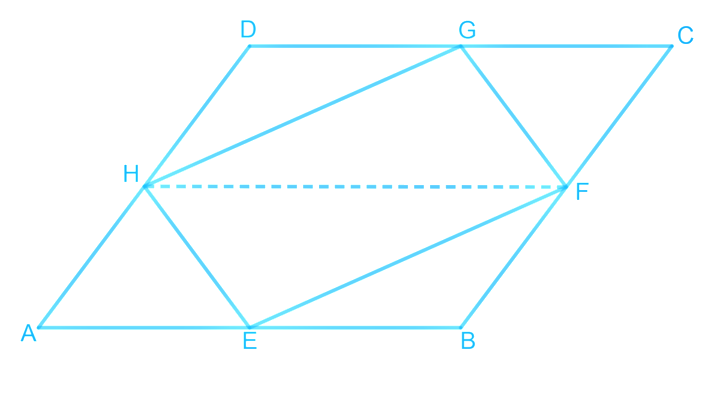
Given : E, F, G and H are the mid-points of the sides of a parallelogram ABCD, respectively.
To Prove : ar (EFGH) = ½ ar(ABCD)
Construction : H and F are joined.
AD || BC and AD = BC (Opposite sides of a parallelogram)
⇒ ½ AD = ½ BC
Also,
AH || BF and and DH || CF
⇒ AH = BF and DH = CF (H and F are mid points)
∴ ABFH and HFCD are parallelograms.
Now,
We know that, ΔEFH and parallelogram ABFH, both lie on the same FH the common base and in-between the same parallel lines AB and HF.
∴ area of EFH = ½ area of ABFH ————-— (i)
And, area of GHF = ½ area of HFCD ————-— (ii)
Adding (i) and (ii),
area of ΔEFH + area of ΔGHF = ½ area of ABFH + ½ area of HFCD
⇒ area of EFGH = ½ (area of ABFH + area of HFCD)
∴ ar (EFGH) = ½ ar(ABCD)
3. P and Q are any two points lying on the sides DC and AD, respectively of a parallelogram ABCD.
Show that ar(APB) = ar(BQC).
Answer – If a triangle and a parallelogram are on the same base and between the same parallel lines, the area of the triangle will be half of the area of the parallelogram.
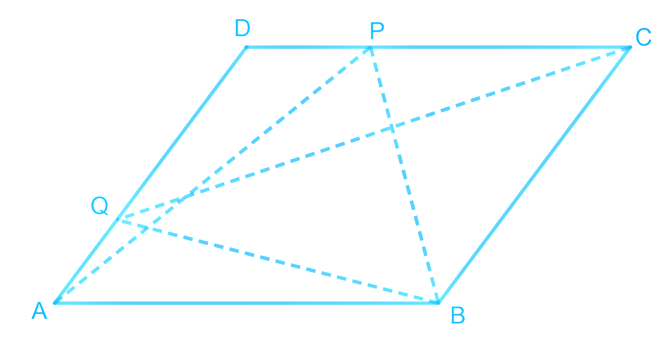
ΔAPB and parallelogram ABCD lie on the same base AB and in-between same parallel AB and DC.
ar(ΔAPB) = ½ ar(parallelogram ABCD) —————— (i)
Similarly,
ar(ΔBQC) = ½ ar(parallelogram ABCD) —————— (ii)
From (i) and (ii), we have
ar(ΔAPB) = ar(ΔBQC)
4. In Fig. 9.16, P is a point in the interior of a parallelogram ABCD. Show that
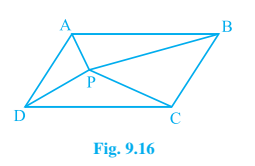
(i) ar(APB) + ar(PCD) = ½ ar(ABCD)
(ii) ar(APD) + ar(PBC) = ar(APB) + ar(PCD)
[Hint : Through P, draw a line parallel to AB.]
Answer – If a triangle and parallelogram are on the same base and between the same parallel lines, then the area of the triangle will be half of the area of the parallelogram.
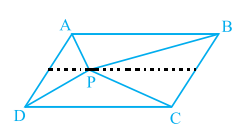
(i) ar(APB) + ar(PCD) = ½ ar(ABCD)
A line GH is drawn parallel to AB passing through P.
In a parallelogram,
AB || GH (by construction) ————— (i)
∴ AD || BC ⇒ AG || BH ————— (ii)
From equations (i) and (ii),
ABHG is a parallelogram.
Now,
ΔAPB and parallelogram ABHG are lying on the same base AB and in-between the same parallel lines AB and GH.
∴ ar(ΔAPB) = ½ ar(ABHG) ————— (iii)
also,
ΔPCD and parallelogram CDGH are lying on the same base CD and in-between the same parallel lines CD and GH.
∴ ar(ΔPCD) = ½ ar(CDGH) ————— (iv)
Adding equations (iii) and (iv),
ar(ΔAPB) + ar(ΔPCD) = ½ [ar(ABHG)+ar(CDGH)]
⇒ ar(APB)+ ar(PCD) = ½ ar(ABCD)
(ii) ar(APD) + ar(PBC) = ar(APB) + ar(PCD)
A line EF is drawn parallel to AD passing through P.
In the parallelogram,
AD || EF (by construction) —————— (i)
∴ AB || CD ⇒ AE || DF —————— (ii)
From equations (i) and (ii),
AEDF is a parallelogram.
Now,
ΔAPD and parallelogram AEFD are lying on the same base AD and in-between the same parallel lines AD and EF.
∴ ar(ΔAPD) = ½ ar(AEFD) —————— (iii)
also,
ΔPBC and parallelogram BCFE are lying on the same base BC and in-between the same parallel lines BC and EF.
∴ ar(ΔPBC) = ½ ar(BCFE) —————— (iv)
Adding equations (iii) and (iv),
ar (ΔAPD)+ ar (ΔPBC) = ½ [ar (AEFD) + ar (BCFE)]
⇒ ar(APD)+ar(PBC) = ar(APB)+ar(PCD)
5. In Fig. 9.17, PQRS and ABRS are parallelograms and X is any point on side BR. Show that
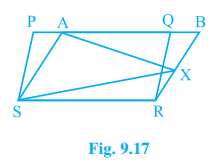
(i) ar (PQRS) = ar (ABRS)
(ii) ar (AXS) = ½ ar (PQRS)
Answer – If a triangle and a parallelogram are on the same base and between the same parallel lines, the area of the triangle will be half of that of a parallelogram or if two parallelograms are on the same and between two parallel lines then their area will be equal.
(i) ar (PQRS) = ar (ABRS)
Parallelogram PQRS and ABRS lie on the same base SR and in-between the same parallel lines SR and PB.
∴ ar(PQRS) = ar(ABRS) ———-— (i)
(ii) ar (AXS) = ½ ar (PQRS)
ΔAXS and parallelogram ABRS are lying on the same base AS and in-between the same parallel lines AS and BR.
∴ ar(ΔAXS) = ½ ar(ABRS) ———-— (ii)
From (i) and (ii), we find that,
ar (ΔAXS) = ½ ar (PQRS)
6. A farmer had a field in the form of a parallelogram PQRS. She took any point A on RS and joined it to points P and Q. In how many parts is the fields divided? What are the shapes of these parts? The farmer wants to sow wheat and pulses in equal portions of the field separately. How should she do it?
Answer – Let’s draw the figure as shown below.
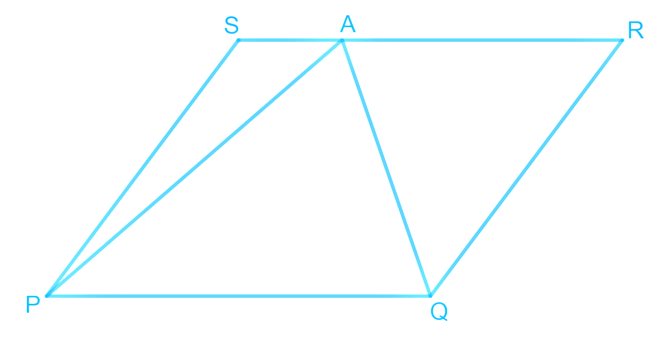
From the figure, it can be observed that point A divides the parallelogram-shaped field into three parts. These parts are triangular in shape: ΔPSA, ΔPAQ, and ΔQRA
From the figure, we can observe that:
Area of ΔPSA + Area of ΔPAQ + Area of ΔQRA = Area of parallelogram PQRS —————— (1)
We know that if a parallelogram and a triangle are on the same base and between the same set of parallel lines, then the area of the triangle is half the area of the parallelogram.
∴ Area (ΔPAQ) = 1/2 Area (PQRS) —————— (2)
From Equations (1) and (2), we obtain
Area (ΔPSA) + Area (ΔQRA) = 1/2 Area (PQRS) —————— (3)
Clearly, it can be observed that the farmer must sow wheat in the triangular part ΔPAQ and pulses in the other two triangular parts – ΔPSA and ΔQRA, or wheat in triangular parts – ΔPSA and ΔQRA and pulses in the triangular part ΔPAQ.

Leave a Reply